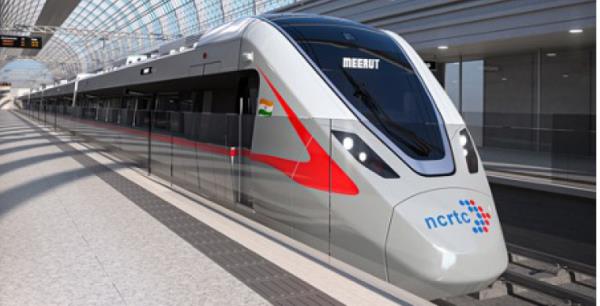10 April 2024

The National Capital Regional Transport Corporation (NCRTC) has identified the Delhi-Ghaziabad-Meerut corridor as the first phase of development of a rapid rail transport network. The development aims to support sustainable economic and social development through increased and improved connectivity between Delhi and the districts and towns surrounding the National Capital Territory.
With an estimated maximum speed of 180kmph, the new line will cut travel time between Delhi and Meerut to less than an hour. Expected to be fully operational by 2025, the network will transport thousands of people, making it a more sustainable transport alternative and reducing congestion on the roads.
Achieving high speeds and high train frequencies requires a reliable and secure communications system that guarantees train-to-ground communications at all times.
Communications at speed
The objective of the National Capital Regional Transport Corporation was to have a modern communications system that, using broadband technology, offers the highest levels of security and availability, as well as equipment that guarantees reliable and stable train-to-ground communications.
However, ensuring the voice communications of all the agents involved in railway operations, while guaranteeing the transmission of large volumes of data that are permanently generated on a running train, is technically challenging and requires a considerable effort and the development of a totally innovative and disruptive proposal.
Accordingly, Teltronic was selected by Alstom to supply and integrate the on-board equipment, radio terminals and the control centre solution to provide the MCX services for the 82km fast rail corridor.
At a time when broadband technology is still emerging in critical sectors, the commitment to MCX represents a pioneering milestone at a global level for medium-distance trains, being the support for both voice and data communications. The ambition to integrate all the elements is a great effort and a tremendously valuable coordination exercise, all following the commands defined in the FRMCS, and bringing the project closer to the future of railway communications.
Onboard 3GPP standard mission critical services
Teltronic’s role in the project included the integration of the on-board equipment, radio dispatchers, smartphones, and the control centre solution to provide the mission critical services (MCX) to the line.
The RTP800 was selected as the on-board equipment, which can orchestrate the train to ground communications with TETRA and/or LTE. It complies with the 3GPP standard for FRMCS and MCX services, supporting all the communication needs in the very demanding transport sector. Certified according to railway regulations EN50155 and EN45545, the solution features two units per train (one in each cabin), managing different levels of redundancy to increase reliability.
MCX functionality was implemented in combination with the rest of on-board integrations, a pioneering milestone in terms of on-board equipment. The on-board solution is completed with the control console with touchscreen that allows its operation, and by the audio accessories.
Teltronic also addressed integration with various train subsystems, including the public address, intercom systems, and the train control & management system (TCMS). The on-board equipment is also connected to the router that manages train-ground connectivity for all services.
For the control centre, Teltronic deployed its NG CeCoCo solution with ten console positions. Designed for touchscreen operation, it enables communication between operators and external contacts to the control room through different networks.
Moreover, the console position is configured for different operator profiles and is the single HMI for providing a wide variety of voice and messaging communication services. It includes a dynamic map of the transport infrastructure that allows real-time visualisation of the location of trains, supervised according to several areas of control, and specific functionality like coupling, TRN assignment or alarm management.
In addition to being the onboard communications management platform, NG CeCoCo is integrated with the trackside Train Management System (TMS) to receive operational information such as alarms and train location. It also manages voice and data communications between the trains and the controllers of control centre, which complies with the commands defined by 3GPP for FRMCS and allows the control centre to communicate directly with the train passengers through the PA and intercom systems, either with pre-recorded messages or not.
The solution also includes LTE handheld terminals and LTE desktops dispatch units. The set is completed with different audio accessories, as a handset that allows private conversations or a desktop microphone.
Enabling sustainable development
The Delhi-Ghaziabad-Meerut corridor aims to enable sustainable economic and social development through greater and better connectivity between Delhi and the surrounding districts and cities. With that ambition, Teltronic is involved in making travel safer and faster for the millions of users of the line.
The use of next generation telecommunications technology will make it possible to shorten Delhi-Meerut commute time by 40%, carry 800,000 passengers each day, and help decongest roads and reduce pollution up to 250,000 tonnes of CO2 emissions a year – an impressive achievement by any standard.
“This project is a clear demonstration that our solutions for railway environments comply with the 3GPP standard for MCX services. Teltronic reaffirms its commitment to standards as a reference framework and after a clear target to R&D to evolve our solutions to the technologies of the future, we are proud that Alstom has selected us and that we can demonstrate that Teltronic will continue to play a key role in private communications,” said Felipe Sanjuán, transport business development director, Teltronic. “We have proved the validity of Teltronic’s communication solutions over MCX defined by the 3GPP standard; setting a new milestone in rail communications with a technology that will allow the line operator a smooth transition to FRMCS (Future Rail Mobile Communication System) in the future.”







